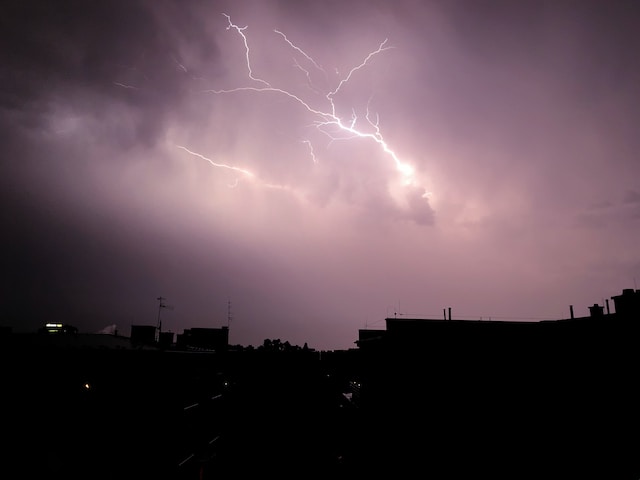Thunderstorms are powerful natural events that bring rain, lightning, and sometimes even hail and strong winds. When it comes to thunderstorms, two common terms you may come across are “isolated” and “scattered.”
Understanding the difference between isolated and scattered thunderstorms is crucial for staying informed and prepared. In this guide, we’ll explore the characteristics of each type and provide valuable insights on how to navigate these weather conditions.
Cracking the Code: Isolated Thunderstorms
Let us begin our exploration with isolated thunderstorms, enigmatic phenomena that occur within a confined geographical area. Picture a solitary thunderstorm, dancing in solitude amidst the vast canvas of the sky. Isolated thunderstorms are characterized by their lonesome nature, sparse in occurrence across a given region. They tend to cover less than 20% of the affected area, making their impact limited.
The genesis of isolated thunderstorms lies in localized weather conditions, where intricate interplays of temperature variations, moisture levels, and atmospheric instability unfold.
These tempestuous entities can emerge as a response to diverse factors, ranging from gentle sea breezes to the imposing presence of topographic features. Even the collision of different air masses can give rise to these isolated marvels. However, it is important to note that the lifespan of isolated thunderstorms is often brief, dissipating into the ether almost as swiftly as they appeared.
To further delve into the captivating world of isolated thunderstorms, let us expand our understanding and explore their characteristics in more detail. The following table provides a comprehensive overview of the key features of isolated thunderstorms:
| Characteristics | Description |
|---|---|
| Geographic Area | Isolated thunderstorms occur within a limited geographical area. They are confined to a specific region, making their impact localized. |
| Coverage | These thunderstorms typically cover less than 20% of the affected area. While their presence may be significant in the immediate vicinity, their influence diminishes as you venture further from the storm’s epicenter. |
| Occurrence | Isolated thunderstorms are relatively sparse in occurrence. They appear infrequently across a given region, contributing to their solitary nature. |
| Weather Factors | Isolated thunderstorms arise from localized weather conditions. Temperature variations, moisture levels, and atmospheric instability play crucial roles in their development. |
| Trigger Mechanisms | Various factors can trigger isolated thunderstorms. Gentle sea breezes, the presence of topographic features such as mountains or coastlines, and the collision of different air masses can all contribute to the formation of these captivating weather phenomena. |
| Lifespan | The lifespan of isolated thunderstorms is often brief. These tempestuous entities tend to dissipate relatively quickly, fading away as swiftly as they appeared. |
As you can see, isolated thunderstorms possess distinct characteristics that set them apart from their counterparts. Their confined nature, limited coverage, and sparse occurrence contribute to their enigmatic allure. These solitary storms owe their existence to localized weather conditions, where the interplay of temperature, moisture, and atmospheric instability gives birth to their tumultuous dance. However, their fleeting nature means that their impact is transient, and they soon fade away, leaving behind an air of mystery.
Unveiling the Riddle: Scattered Thunderstorms

As we delve deeper into the realms of thunderstorms, we encounter their scattered brethren—a grand tapestry of thunderstorm activity that sprawls across a larger expanse. Imagine multiple thunderstorms, like celestial brushstrokes on the canvas of the atmosphere, painting a vivid tableau of nature’s fury. Scattered thunderstorms manifest as an ensemble of thunderstorms that develop over approximately 30-50% of the affected region. While not as extensive as the term “numerous” implies, scattered thunderstorms command a greater presence than their isolated counterparts.
The genesis of scattered thunderstorms lies in the convergence of atmospheric moisture and instability on a broader scale. These atmospheric conditions provide a fertile breeding ground for the proliferation of thunderstorms. The emergence of scattered thunderstorms is often influenced by atmospheric systems such as frontal boundaries, troughs, or upper-level disturbances. Unlike isolated thunderstorms, scattered thunderstorms tend to persist for longer durations, meandering their way across the region or redeveloping in the same general area.
Here’s a table highlighting the characteristics of scattered thunderstorms:
| Characteristics | Description |
|---|---|
| Geographic Area | Scattered thunderstorms have a broader reach compared to isolated thunderstorms. They develop across a larger geographical area, resulting in a more widespread impact. |
| Coverage | These thunderstorms typically cover approximately 30-50% of the affected region. While they are not as widespread as “numerous” thunderstorms, their coverage extends beyond that of isolated storms, creating a more extensive weather pattern. |
| Occurrence | Scattered thunderstorms occur more frequently compared to isolated thunderstorms. The presence of multiple storms across the region increases the likelihood of encountering them. |
| Duration | Scattered thunderstorms have a longer duration compared to isolated thunderstorms. They can persist for hours, allowing for a greater opportunity for precipitation, lightning, and other associated phenomena. |
| Movement | These thunderstorms exhibit variable movement patterns. They may move gradually across the region, influenced by atmospheric conditions and weather systems such as frontal boundaries or upper-level disturbances. |
| Impact | Due to their broader coverage and longer duration, scattered thunderstorms have the potential to affect a larger population and a wider range of activities. They can disrupt outdoor events, pose hazards to transportation, and impact various socio-economic sectors. |
Cracking the Forecast: Preparing for the Unpredictable
Whether you find yourself amidst isolated or scattered thunderstorms, it is imperative to be prepared and equipped to navigate these unpredictable weather phenomena. Here are some indispensable tips to help you weather the storm:
- Stay informed: Keep a vigilant eye on weather forecasts and heed the warnings issued by local meteorological authorities. These invaluable resources will provide you with crucial information about the potential occurrence of isolated or scattered thunderstorms in your vicinity;
- Seek shelter: When thunderstorms loom on the horizon, find solace in a safe shelter that shields you from the wrath of lightning and potential hazards. Sturdy buildings or fully enclosed vehicles offer respite, while open spaces, tall trees, and bodies of water should be avoided;
- Exercise caution outdoors: If you must venture into the tempestuous outdoors during thunderstorm activity, exercise utmost caution. Steer clear of open fields, hilltops, and elevated areas that make you vulnerable to lightning strikes. Remember, the sound of thunder is a harbinger of nearby lightning, prompting you to seek shelter promptly;
- Beware of electrical devices: Thunderstorms and electricity make for a precarious combination. Unplug electrical appliances, and refrain from using corded phones or electronic devices connected to power outlets during these tumultuous times. Lightning possesses the ability to traverse electrical wiring, putting you at risk of electric shock;
- Prepare an emergency kit: A well-stocked emergency kit is a veritable lifeline during thunderstorms. Ensure it includes essential supplies such as flashlights, batteries, a first aid kit, non-perishable food, and an ample supply of drinking water. This kit will prove invaluable during power outages or if you find yourself seeking shelter for an extended period;
- Stay updated with weather alerts: Harness the power of technology by utilizing weather apps or tuning in to local radio stations for real-time updates and emergency alerts. These invaluable sources of information will keep you apprised of the progress of thunderstorms and any potential threats they may pose.
Conclusion
As we conclude our journey through the realm of thunderstorms, armed with the knowledge of isolated and scattered phenomena, we stand better prepared to face the capricious nature of these atmospheric marvels. Whether you find yourself in the midst of isolated thunderstorms, solitary and fleeting, or scattered thunderstorms, an ensemble of nature’s fury, remember to stay informed, seek shelter, and prioritize your well-being.
By heeding weather forecasts, exercising caution, and fortifying yourself against potential hazards, you can dance amidst the thunderous symphony of nature with confidence and resilience.
FAQ
Severity cannot be attributed solely to the isolated or scattered nature of thunderstorms. Both types of thunderstorms are capable of unleashing severe weather conditions, including heavy rainfall, lightning, and strong winds. To gauge the potential impact, it is crucial to stay informed about the specific conditions associated with a thunderstorm.
Indeed, isolated thunderstorms possess the potential to evolve into scattered thunderstorms under specific circumstances. As localized factors fluctuate or weather systems interact, isolated thunderstorms may merge or give birth to new thunderstorms in close proximity, ultimately expanding the coverage of thunderstorm activity.
To fortify your abode against the wrath of thunderstorms, ensure your roof is in impeccable condition, devoid of loose materials that may be carried away by strong winds. Prune tree branches that loom perilously close to your home to minimize the risk of damage from falling limbs. Additionally, contemplate the installation of lightning rods or surge protectors to shield your electrical system.
Thunderstorms, be they isolated or scattered, have the potential to unleash heavy downpours that can trigger flash floods, particularly in areas with inadequate drainage or low-lying terrain. Familiarize yourself with flood-prone regions and adhere to the guidance of local authorities regarding evacuation or safety measures during episodes of torrential rain.
Thunderstorms can grace us with their presence throughout the year in diverse regions, although their frequency and intensity may vary based on local climatic conditions. In certain areas, isolated or scattered thunderstorms may be more prevalent during specific seasons, such as the summer months when atmospheric conditions are ripe for their formation.


